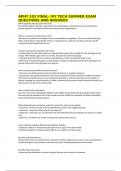Exam (elaborations)
APHY 102 FINAL- IVY TECH SUMMER EXAM QUESTIONS AND ANSWERS
- Course
- Institution
APHY 102 FINAL- IVY TECH SUMMER EXAM QUESTIONS AND ANSWERS What regulates pituitary gland secretion? The pituitary gland is directly connected to the hypothalamus. Secretion from the 2 lobes of the pituitary gland is controlled by different methods by the hypothalamus What is a hormone and h...
[Show more]



